Influence of Reed Fiber Length and Dosage on the Properties of Reed-Fiber-Modified Bitumen and Bituminous Mortar
Abstract
:1. Introduction
2. Materials and Methods
2.1. Raw Materials
2.1.1. Base Bitumen
2.1.2. Reed Fiber
2.2. Preparation of the Modified Bitumen
- (1)
- The reed fibers were weighed according to specified dosages based on the weight of the bitumen;
- (2)
- The bitumen and fibers were combined and placed in an oven, where they were heated to 150 °C;
- (3)
- Subsequently, the heated mixture was gradually introduced into the bitumen and blended at low speed for 30 min to achieve even dispersion of the fibers.
2.3. Test Methods
2.3.1. Fourier-Transform Infrared Spectroscopy (FTIR)
2.3.2. Viscosity
2.3.3. Rheological Measurements
2.3.4. Monotonic Tensile Testing of Mortar Reinforced with Reed Fibers
3. Results and Discussion
3.1. FTIR
3.2. Viscosity
3.3. Frequency Sweep
3.4. MSCR
3.5. Relaxation Test
3.6. Linear Amplitude Sweep
3.7. Monotonic Tensile Testing of Mortar Reinforced with Reed Fibers
3.8. Ranking
4. Conclusions
- 1
- Chemical Characterization: FTIR analysis revealed that the addition of fibers did not alter the chemical structure of bitumen, confirming a purely physical blending process. Increased fiber dosage led to higher peak areas in RFMB spectra, particularly in the C-C stretch region of reed fibers, which serves as a criterion for determining optimal fiber dosage levels;
- 2
- Viscosity: The viscosity of RFMB increased proportionally with higher fiber dosage. Longer fibers contributed to higher viscosity under equivalent dosage levels, although the effect was relatively minor, highlighting the role of fiber length in influencing viscosity;
- 3
- Rheological Tests: Results from rheological tests indicated that adding reed fibers enhanced the complex shear modulus of bitumen, improving its performance at high temperatures; however, at low temperatures, higher fiber dosages exacerbated stiffness, indicating reduced flexibility. RFMB exhibited superior fatigue and rutting resistance but demonstrated poor stress sensitivity;
- 4
- Tensile Strength Tests: Monotonic tensile tests on RFBM mortar showed varying effects of fiber addition. Significant improvements were observed primarily in mortars containing 0.4–0.6 mm and 0.8 mm fiber lengths. The shorter 0.4 mm fibers exhibited less pronounced reinforcement effects on bitumen, possibly due to uneven distribution during sample preparation, necessitating refinement in preparation methods for future studies;
- 5
- Ranking: Based on the tests, bitumen modified with 2% of 0.4 to 0.6 mm reed fibers shows the best overall performance compared to other fiber dosages and types, consistently outperforming virgin bitumen. However, higher fiber dosages like 10% perform inadequately at low temperatures, indicating limitations in colder climates.
Author Contributions
Funding
Data Availability Statement
Conflicts of Interest
References
- Chen, H.; Huang, S.; Niu, D.; Gao, Y.; Zhang, Z. Fatigue characterization and assessment methods for the terminal blend crumb rubber/SBS composite modified asphalt binders. Constr. Build. Mater. 2024, 430, 136357. [Google Scholar] [CrossRef]
- Xu, J.; Liu, M.; Kang, A.; Wu, Z.; Kou, C.; Zhang, Y.; Xiao, P. Effect of fiber characteristic parameters on the synergistic action and mechanism of basalt fiber asphalt mortar. Constr. Build. Mater. 2024, 438, 137234. [Google Scholar] [CrossRef]
- Li, H.; Liu, S.; Yang, F.; He, S.; Jing, H.; Zou, X.; Li, Z.; Sheng, Y. Review of utilization of bamboo fiber in asphalt modification: Insights into preparation, performance, reinforcement, and challenges. J. Clean. Prod. 2024, 468, 143010. [Google Scholar] [CrossRef]
- Niu, D.; Zhang, Z.; Gao, Y.; Li, Y.; Yang, Z.; Niu, Y. Effect of pretreated cow dung fiber on rheological and fatigue properties of asphalt binder. Cellulose 2023, 30, 3773–3791. [Google Scholar] [CrossRef]
- Morea, F.; Zerbino, R. Improvement of asphalt mixture performance with glass macro-fibers—ScienceDirect. Constr. Build. Mater. 2018, 164, 113–120. [Google Scholar] [CrossRef]
- Zhao, H.; Li, G.; Ma, Y.; Yu, X.; Chen, Y.; Li, W. Long-term performance of chemically modified cotton straw fibers in micro-surfacing asphalt mixtures. Case Stud. Constr. Mater. 2024, 20, e03294. [Google Scholar] [CrossRef]
- Gu, Y.; Li, H.; Wang, T.; Kong, J. Heat insulating properties of mullite hollow fibers prepared by using the template of reed fibers. Open Ceram. 2023, 16, 100490. [Google Scholar] [CrossRef]
- Kbbing, J.; Thevs, N.; Zerbe, S. The utilisation of Reed (Phragmites australis)—A review. Mires Peat 2013, 13, 1–14. [Google Scholar]
- Wang, X.; Deng, Y.; Wang, S.; Liao, C.; Meng, Y.; Pham, T. Nanoscale Characterization of Reed Stalk Fiber Cell Walls. BioResources 2013, 8, 1986–1996. [Google Scholar] [CrossRef]
- Shon, C.S.; Mukashev, T.; Lee, D.; Zhang, D.; Kim, J.R. Can Common Reed Fiber Become an Effective Construction Material? Physical, Mechanical, and Thermal Properties of Mortar Mixture Containing Common Reed Fiber. Sustainability 2019, 11, 903. [Google Scholar] [CrossRef]
- Bellatrache, Y.; Ziyani, L.; Dony, A.; Taki, M.; Haddadi, S. Effects of the addition of date palm fibers on the physical, rheological and thermal properties of bitumen. Constr. Build. Mater. 2020, 239, 117808. [Google Scholar] [CrossRef]
- Chen, Z.; Yi, J.; Chen, Z.; Feng, D. Properties of asphalt binder modified by corn stalk fiber. Constr. Build. Mater. 2019, 212, 225–235. [Google Scholar] [CrossRef]
- Fitzgerald, R. Novel Applications of Carbon Fiber for Hot Mix Asphalt Reinforcement and Carbon-Carbon Pre-Forms. 2000. Available online: https://api.semanticscholar.org/CorpusID:138684383 (accessed on 29 August 2024).
- ASTM D5/D5M-20; Standard Test Method for Penetration of Bituminous Materials. ASTM International: West Conshohocken, PA, USA, 2020. Available online: https://www.astm.org/Standards/D5.htm (accessed on 29 August 2024).
- ASTM D36/D36M-14; Standard Test Method for Softening Point of Bitumen (Ring-and-Ball Apparatus). ASTM International: West Conshohocken, PA, USA, 2020. Available online: https://www.astm.org/Standards/D36.htm (accessed on 29 August 2024).
- AASHTO T 316-2019; Standard Method of Test for Viscosity Determination of Asphalt Binder Using Rotational Viscometer. American Association of State Highway and Transportation Officials: Washington, DC, USA, 2019. Available online: https://www.transportation.org (accessed on 29 August 2024).
- EN 15326:2007+A1:2009; Bitumen and Bituminous Binders—Measurement of Density and Specific Gravity—Capillary-Stoppered Pyknometer Method. European Committee for Standardization: Brussels, Belgium, 2009. Available online: https://www.cen.eu (accessed on 29 August 2024).
- ASTM D4124; Standard Test Method for Separation of Asphalt into Four Fractions. ASTM International: West Conshohocken, PA, USA, 2020. Available online: https://www.astm.org/Standards/D4124.htm (accessed on 29 August 2024).
- ASTM D7343; Standard Test Method for Determination of Viscosity of Asphalt Binder Using Rotational Viscometer. ASTM International: West Conshohocken, PA, USA, 2020. Available online: https://www.astm.org/Standards/D7343.htm (accessed on 29 August 2024).
- AASHTO M320; Standard Specification for Performance-Graded Asphalt Binder. American Association of State Highway and Transportation Officials: Washington, DC, USA, 2020. Available online: https://www.transportation.org (accessed on 29 August 2024).
- Xia, C.; Garcia, A.C.; Shi, S.Q.; Qiu, Y.; Warner, N.; Wu, Y.; Cai, L.; Rizvi, H.R.; D’Souza, N.A.; Nie, X. Hybrid boron nitride-natural fiber composites for enhanced thermal conductivity. Sci. Rep. 2016, 6, 34726. [Google Scholar] [CrossRef] [PubMed]
- Wang, F.; Zou, G.; Xu, L.; Fan, S. Investigating the impact of calcium sulfate whisker on the microscopic properties of basalt fiber-reinforced asphalt using molecular dynamics simulation. Constr. Build. Mater. 2024, 421, 135643. [Google Scholar] [CrossRef]
- Li, Z.; Guo, T.; Chen, Y.; Liu, J.; Ma, J.; Wang, J.; Jin, L. Study on pavement performance of cotton straw cellulose modified asphalt. Mater. Res. Express 2022, 9, 025508. [Google Scholar] [CrossRef]
- Yashas, G.T.G.; Sanjay, M.R.; Parameswaranpillai, J.; Siengchin, S. Natural Fibers as Sustainable and Renewable Resource for Development of Eco-Friendly Composites: A Comprehensive Review. Front. Mater. 2019, 6, 226. [Google Scholar] [CrossRef]
- ASTM E1252-98; Standard Practice for General Techniques for Obtaining Infrared Spectra for Qualitative Analysis. ASTM International: West Conshohocken, PA, USA, 1998. Available online: https://www.astm.org/Standards/E1252.htm (accessed on 29 August 2024).
- ASTM D4402-14; Standard Test Method for Viscosity Determination of Asphalt at Elevated Temperatures Using a Rotational Viscometer. ASTM International: West Conshohocken, PA, USA, 2014. Available online: https://www.astm.org/Standards/D4402.htm (accessed on 29 August 2024).
- Dong, W.; Ma, F.; Fu, Z.; Qin, W.; Qi, C.; He, J.; Li, C. Construction and examination of temperature master curve for asphalt with different aging extents. Fuel 2024, 370, 131819. [Google Scholar] [CrossRef]
- ASTM D7175-15; Standard Test Method for Determining the Rheological Properties of Asphalt Binder Using a Dynamic Shear Rheometer (DSR). ASTM International: West Conshohocken, PA, USA, 2015. Available online: https://www.astm.org/Standards/D7175.htm (accessed on 29 August 2024).
- ASTM D7405-15; Standard Test Method for Determining the Low-Temperature Performance Properties of Asphalt Binder Using Dynamic Shear Rheometer (DSR). ASTM International: West Conshohocken, PA, USA, 2015. Available online: https://www.astm.org/Standards/D7405.htm (accessed on 29 August 2024).
- ASTM D7316-15; Standard Test Method for Determining the Elastic Recovery of Asphalt Binder Using a Dynamic Shear Rheometer (DSR). ASTM International: West Conshohocken, PA, USA, 2015. Available online: https://www.astm.org/Standards/D7316.htm (accessed on 29 August 2024).
- Jiao, Y.; Du, W.; Yang, H.; Shi, H. Low temperature failure behavior analysis of fiber reinforced asphalt concrete under indirect tension test using acoustic emission and digital image correlation. Case Stud. Constr. Mater. 2024, 20, e02720. [Google Scholar] [CrossRef]
- Tan, Z.; Leng, Z.; Li, H.; Ashish, P.K.; Cai, X.; Cao, P.; Sreeram, A. Quantitative analysis of asphalt concrete’s tension-compression asymmetry effects on pavement response through 3D numerical modeling with dual viscoelastic model. Constr. Build. Mater. 2024, 430, 136427. [Google Scholar] [CrossRef]
- ASTM C33; Standard Specification for Concrete Aggregates. ASTM International: West Conshohocken, PA, USA, 2022. Available online: https://www.astm.org/Standards/C33.htm (accessed on 29 August 2024).
- Abidi, N.; Cabrales, L.; Hequet, E. Fourier transform infrared spectroscopic approach to the study of the secondary cell wall development in cotton fiber. Cellulose 2010, 17, 309–320. [Google Scholar] [CrossRef]
- Zhang, X.; Zhao, H.; Li, C.; Wang, T.; Peng, L.; Li, Y.; Xiao, Y. In-situ micro-characteristics of fiber at the mortar transition zone in asphalt mixtures. Constr. Build. Mater. 2023, 398, 132529. [Google Scholar] [CrossRef]
- Lee, L.C.; Liong, C.-Y.; Jemain, A.A. A contemporary review on Data Preprocessing (DP) practice strategy in ATR-FTIR spectrum. Chemom. Intell. Lab. Syst. 2017, 163, 64–75. [Google Scholar] [CrossRef]
- AASHTO M332; Standard Specification for Performance-Graded Asphalt Binder Using Multiple Stress Creep Recovery (MSCR) Test. American Association of State Highway and Transportation Officials: Washington, DC, USA, 2021. Available online: https://www.transportation.org (accessed on 29 August 2024).
- Zhang, Z.; Oeser, M. Understanding the damage mechanism of asphalt binder under controlled-stress fatigue loads in dynamic shear rheometer. Constr. Build. Mater. 2021, 292, 123463. [Google Scholar] [CrossRef]
- Moraes, R.; Bahia, H.U. Effects of Curing and Oxidative Aging on Raveling in Emulsion Chip Seals. Transp. Res. Rec. 2018, 2361, 69–79. [Google Scholar] [CrossRef]
- Xu, H.; Wu, S.; Chen, A.; Zou, Y. Influence of erosion factors (time, depths and environment) on induction heating asphalt concrete and its mechanism. J. Clean. Prod. 2022, 363, 132521. [Google Scholar] [CrossRef]
- Yang, Q.; Fan, Z.; Yang, X.; Hao, L.; Lu, G.; Fini, E.H.; Wang, D. Recycling waste fiber-reinforced polymer composites for low-carbon asphalt concrete: The effects of recycled glass fibers on the durability of bituminous composites. J. Clean. Prod. 2023, 423, 138692. [Google Scholar] [CrossRef]
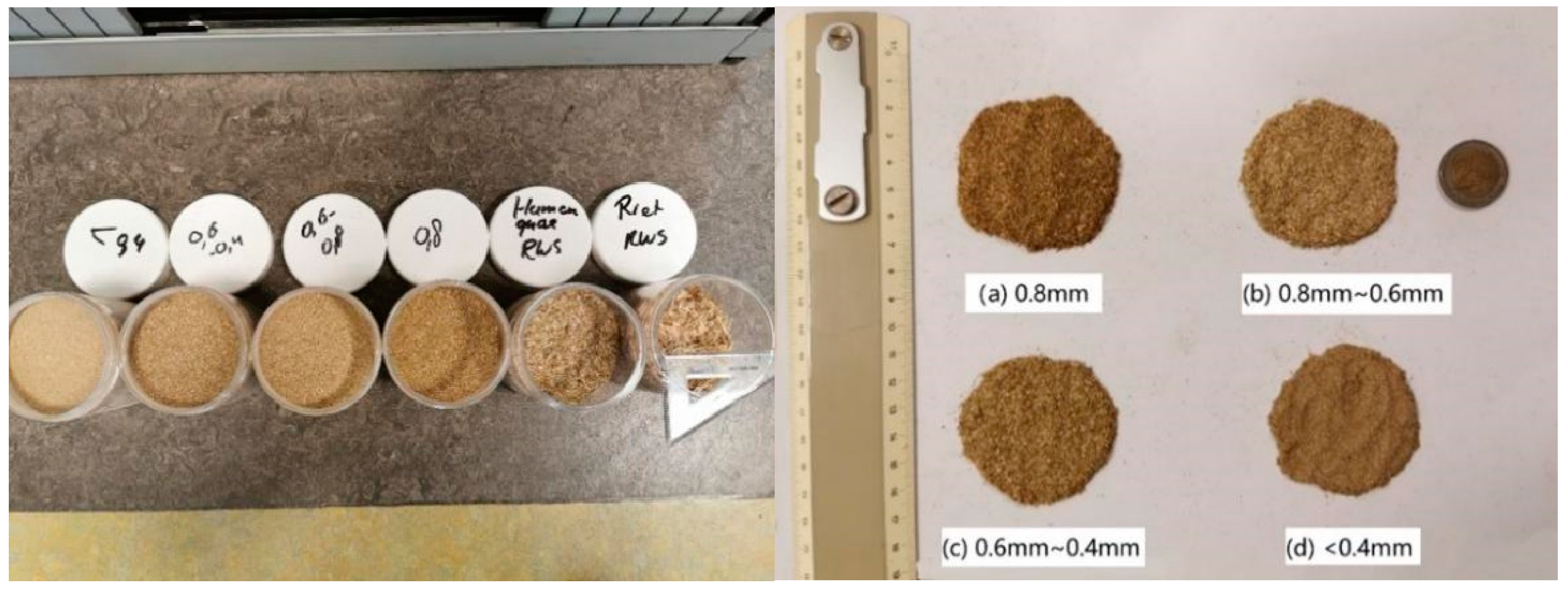
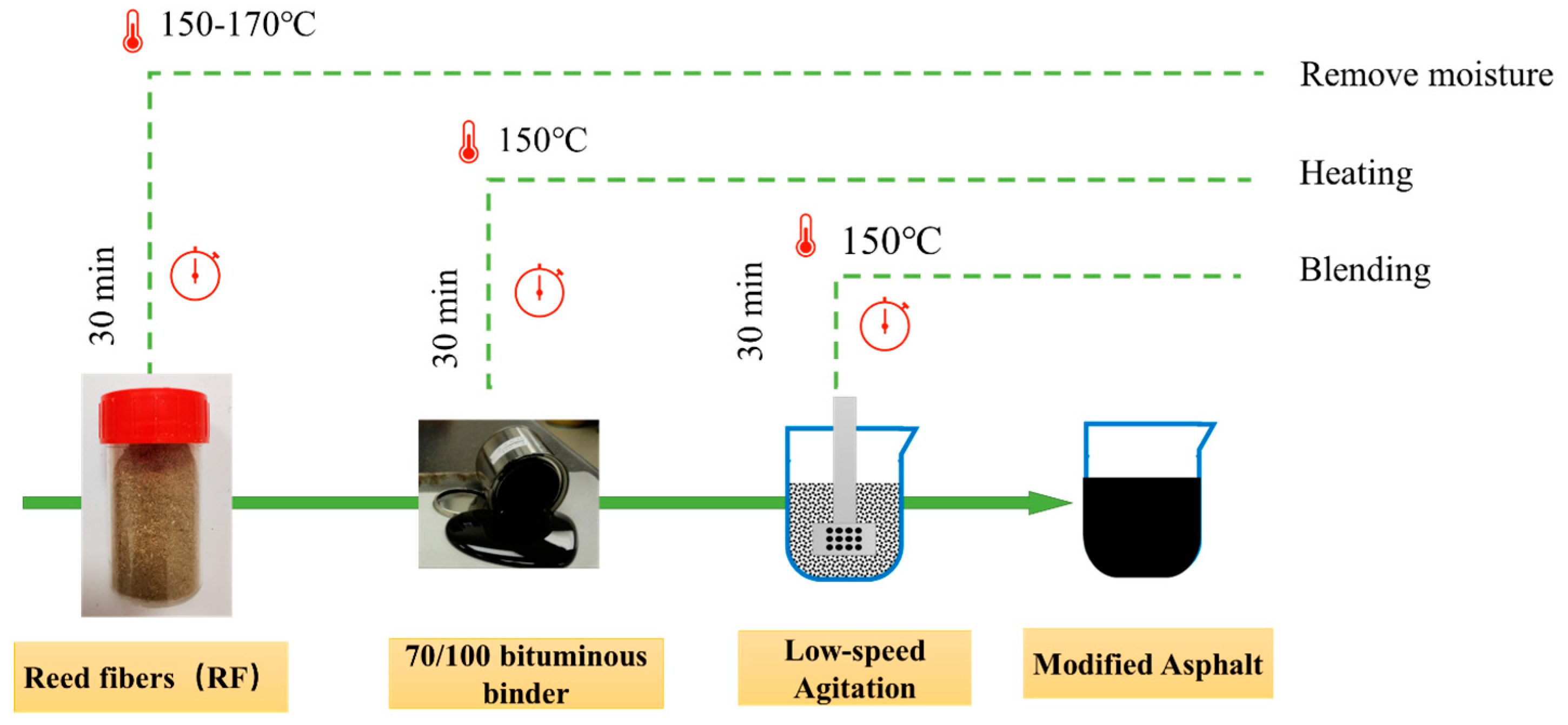
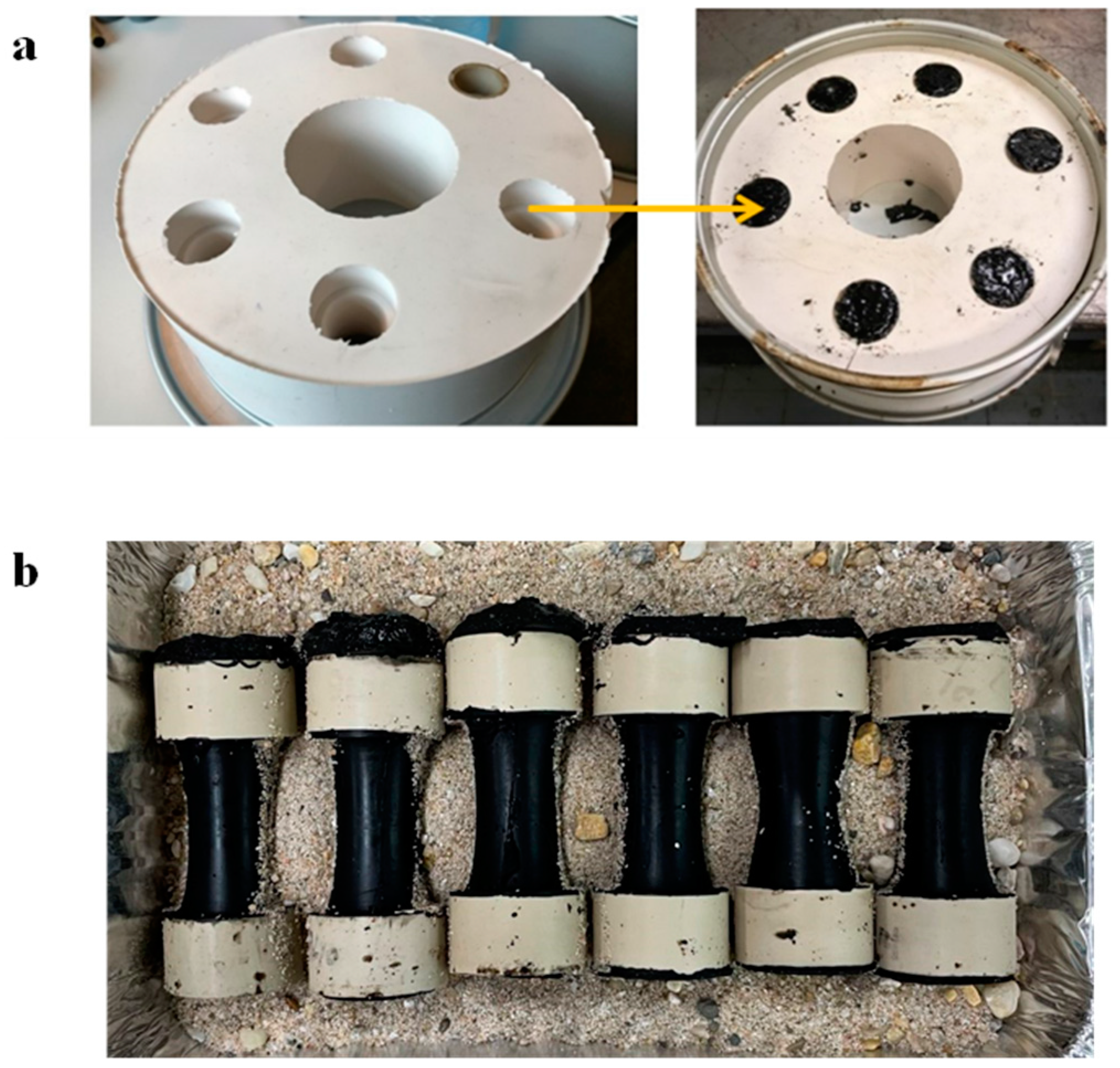
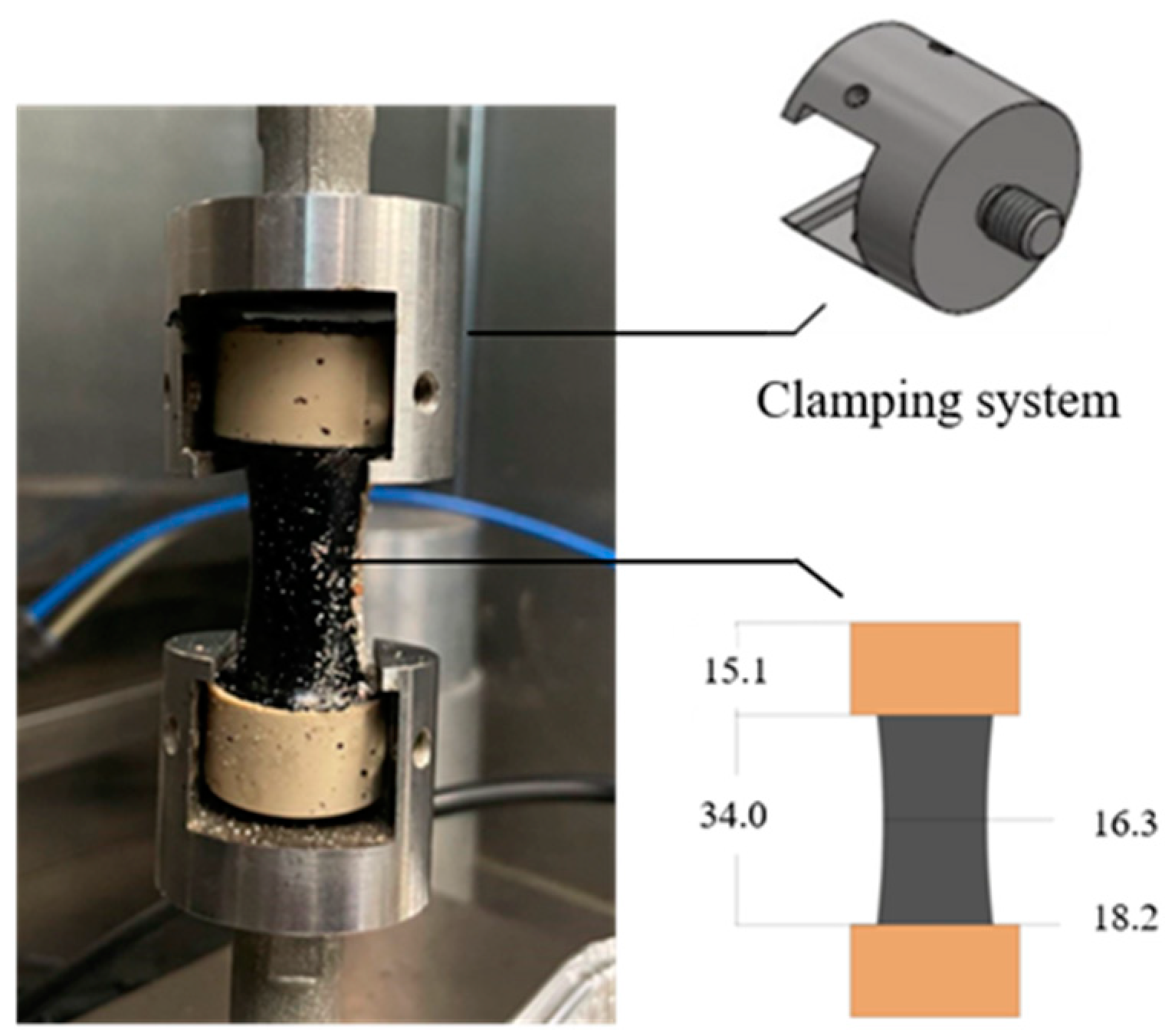

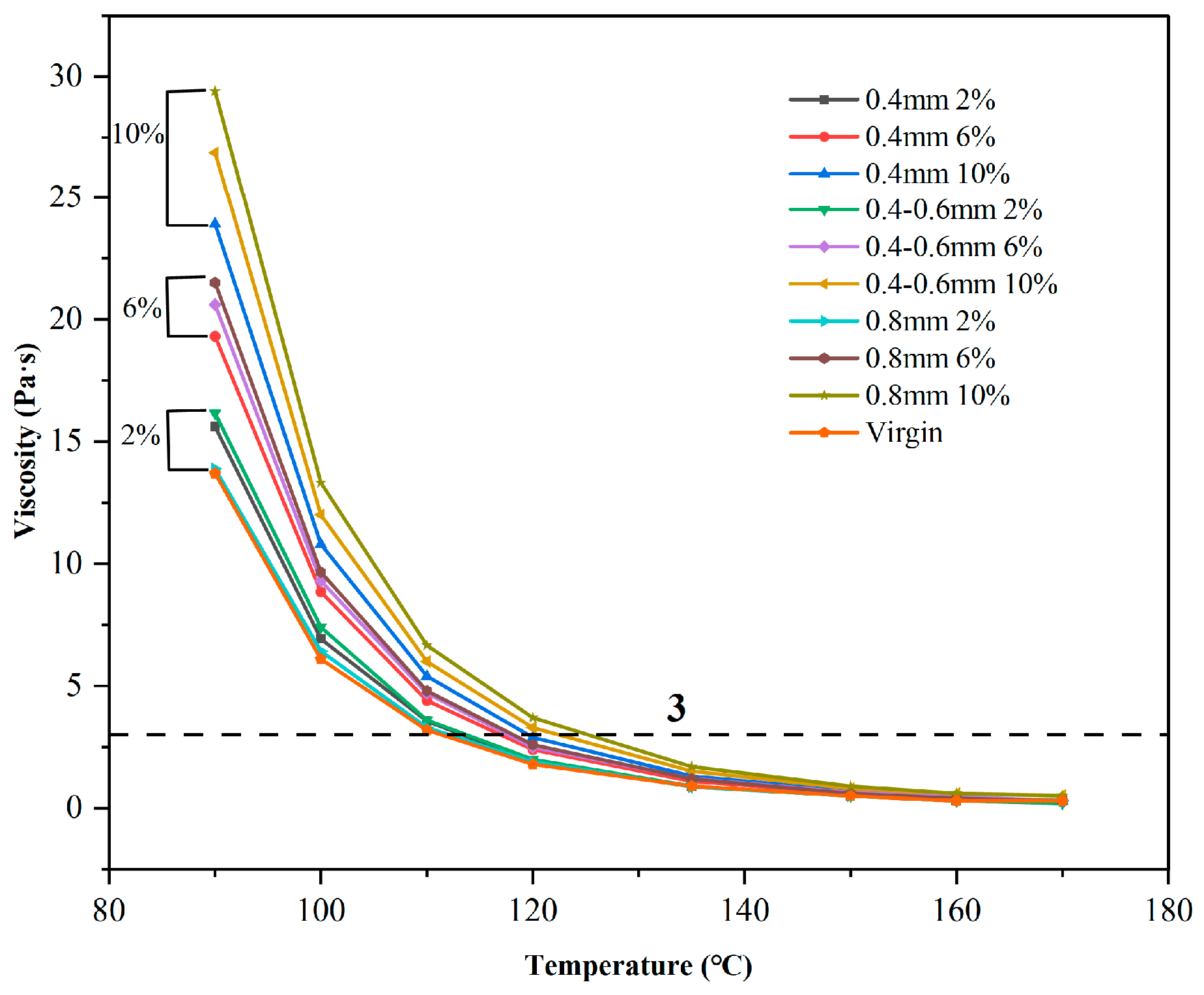

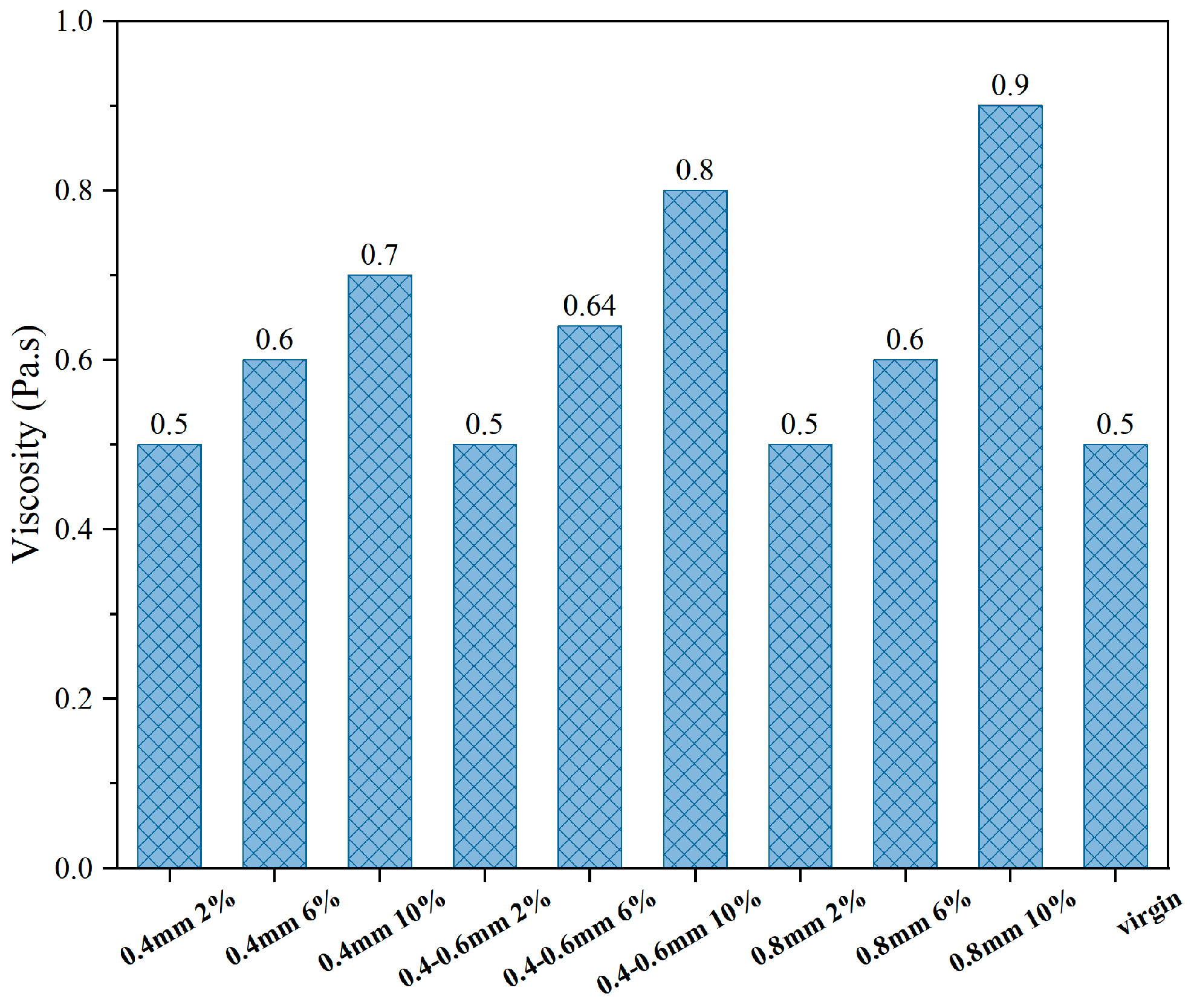
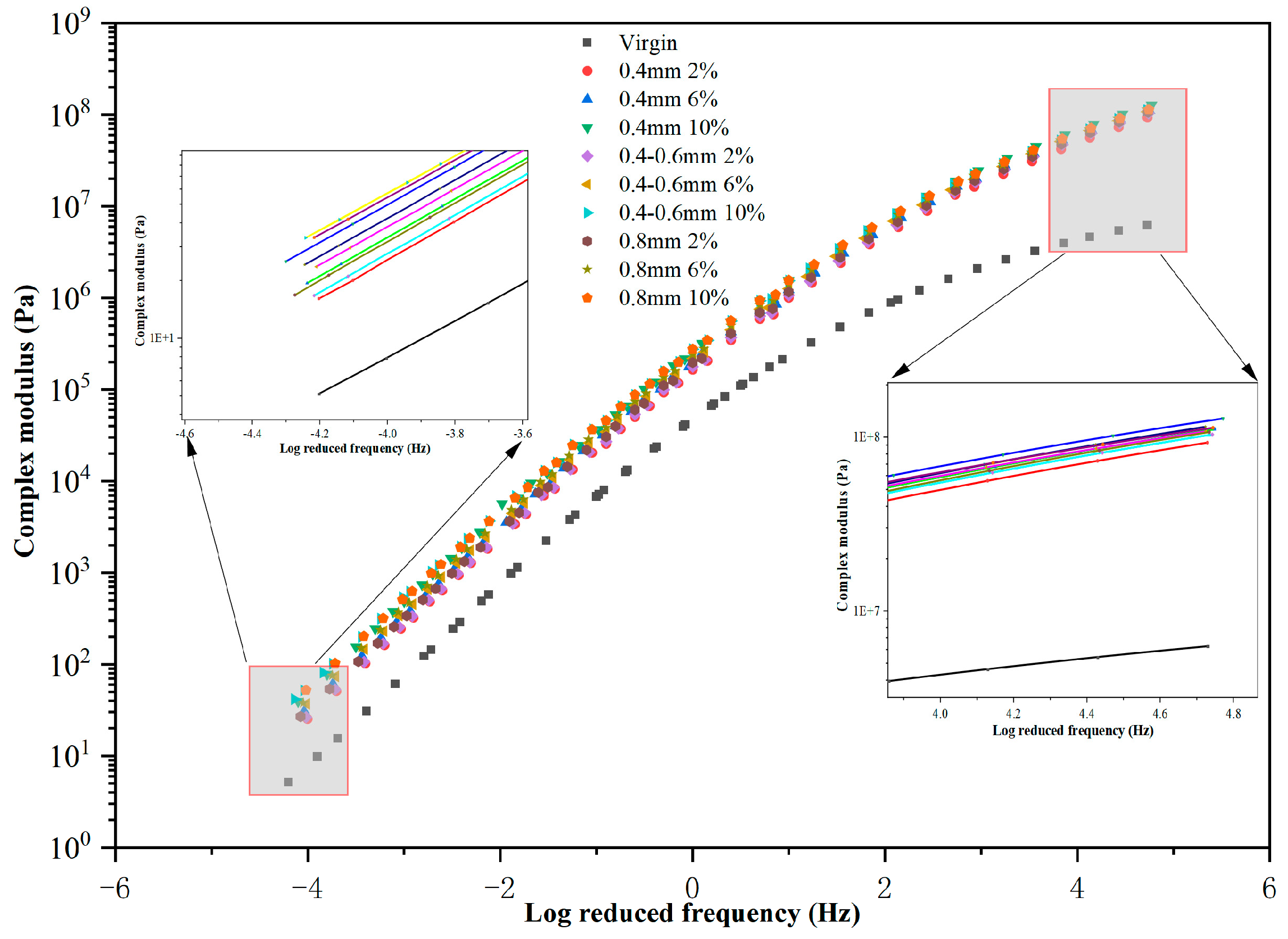
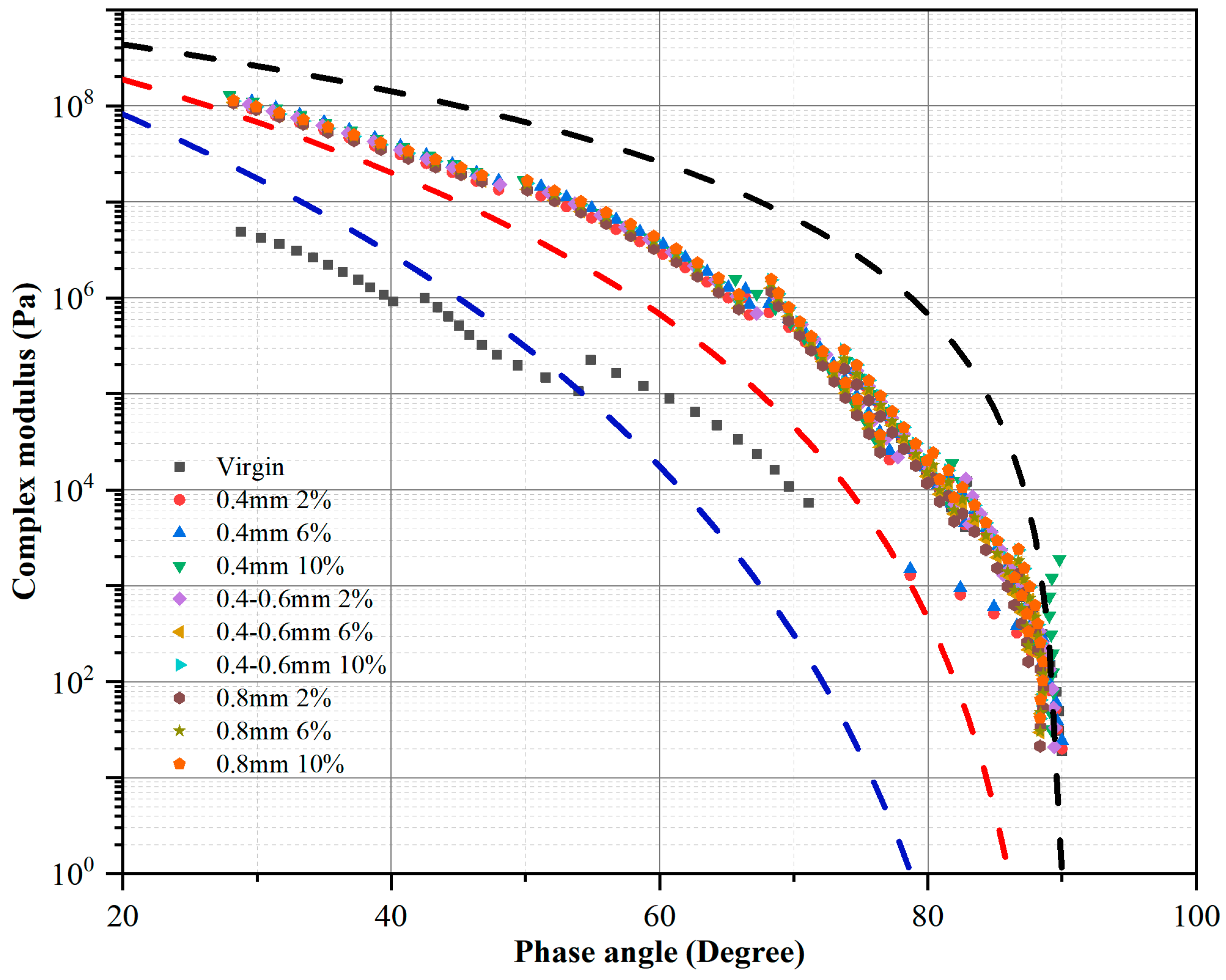
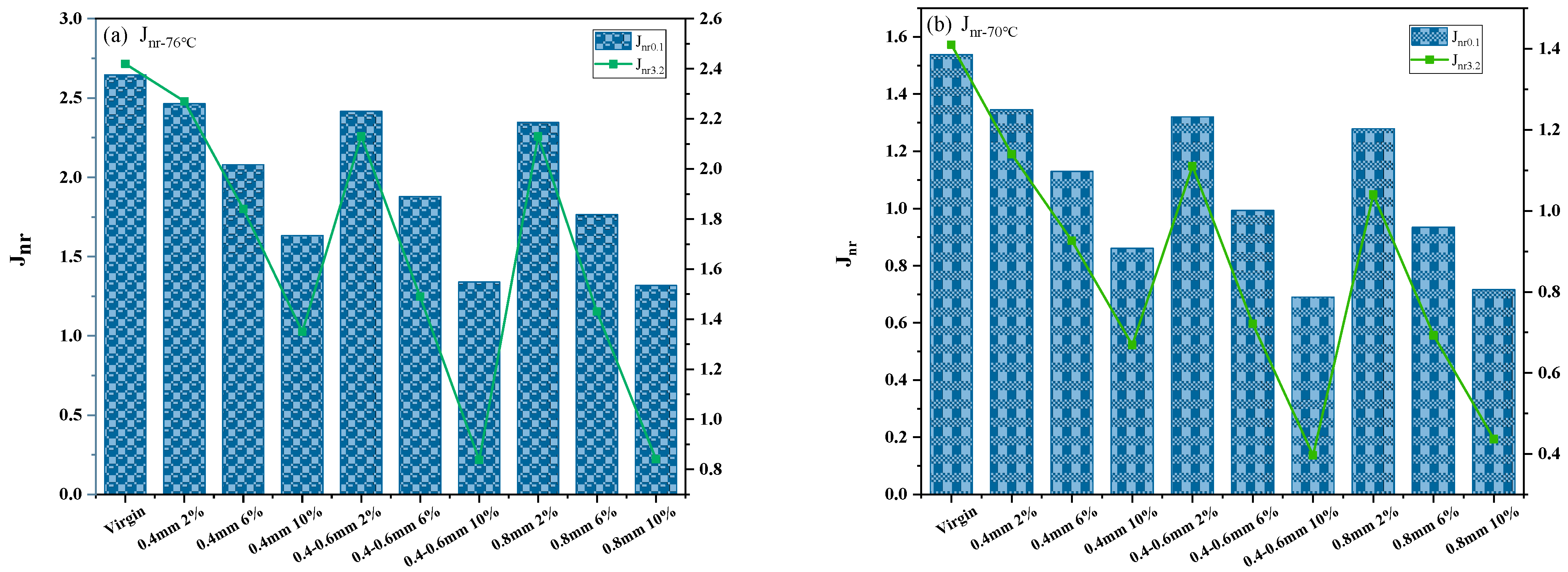
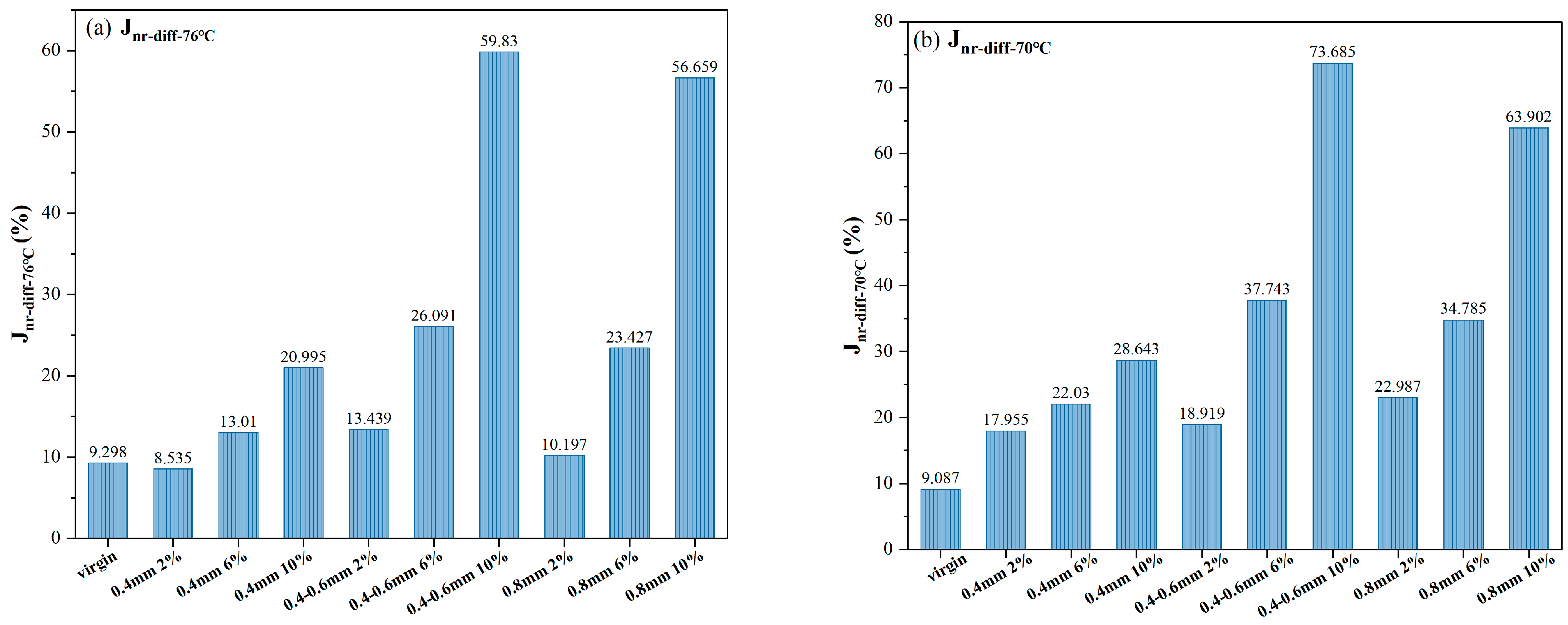
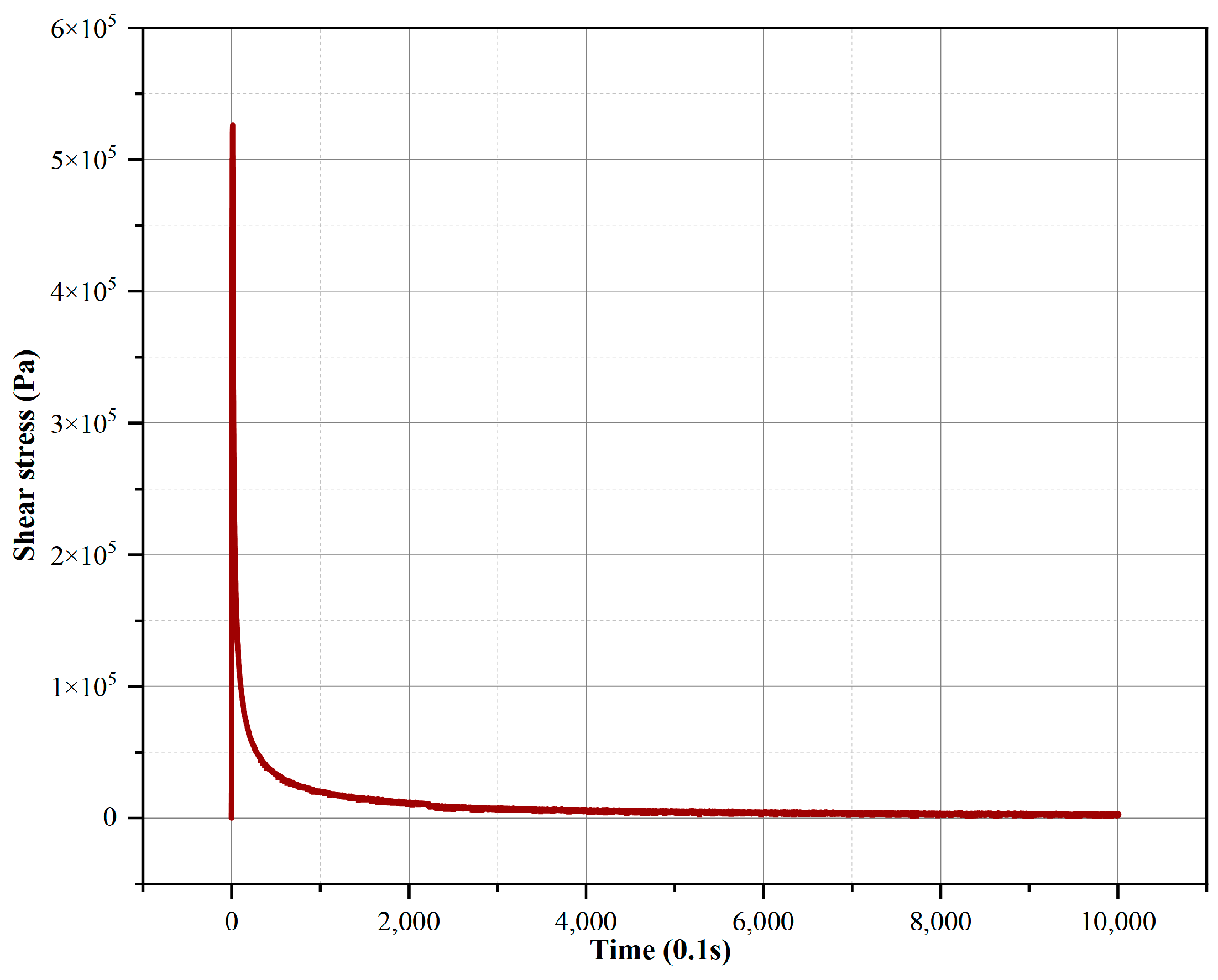
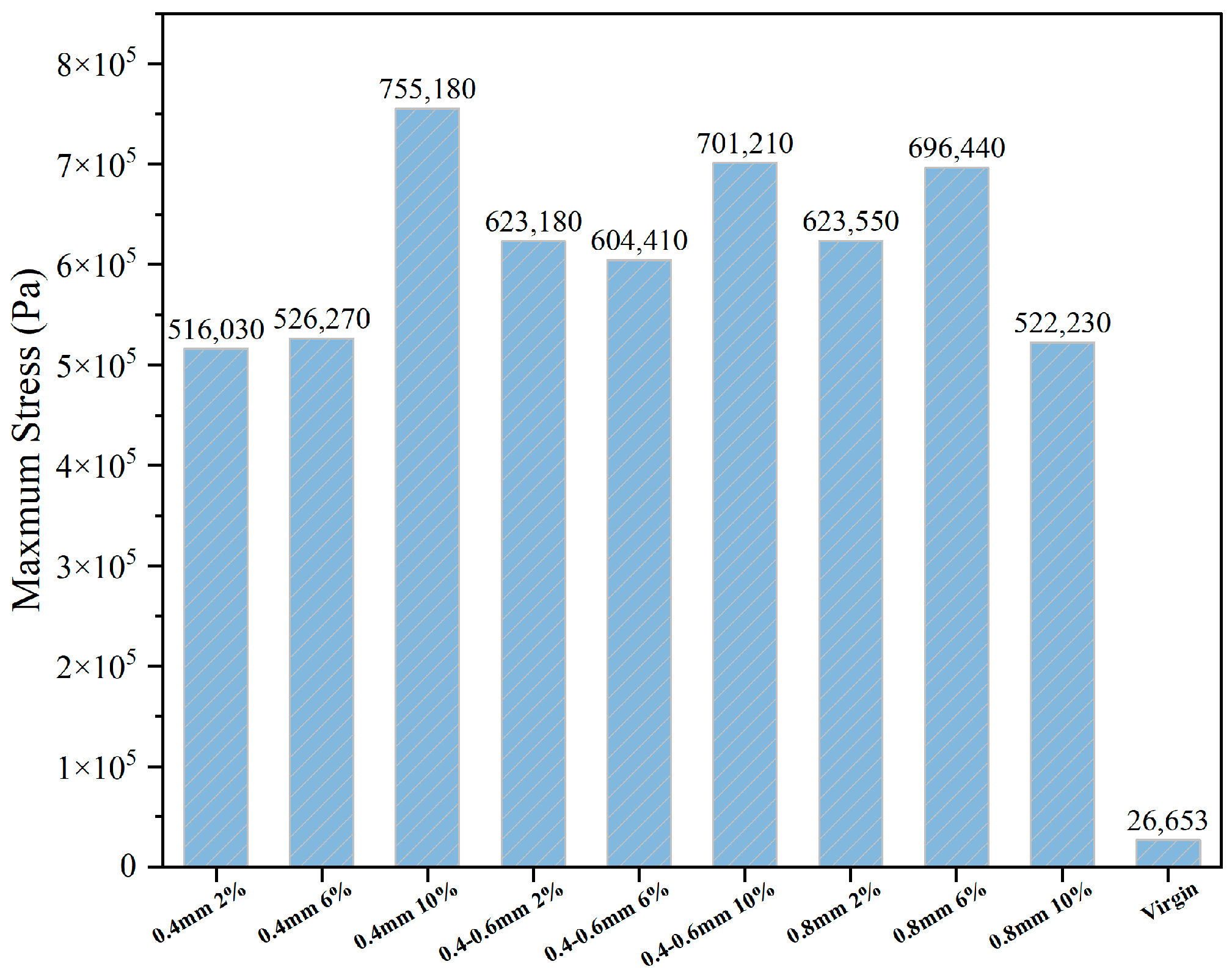


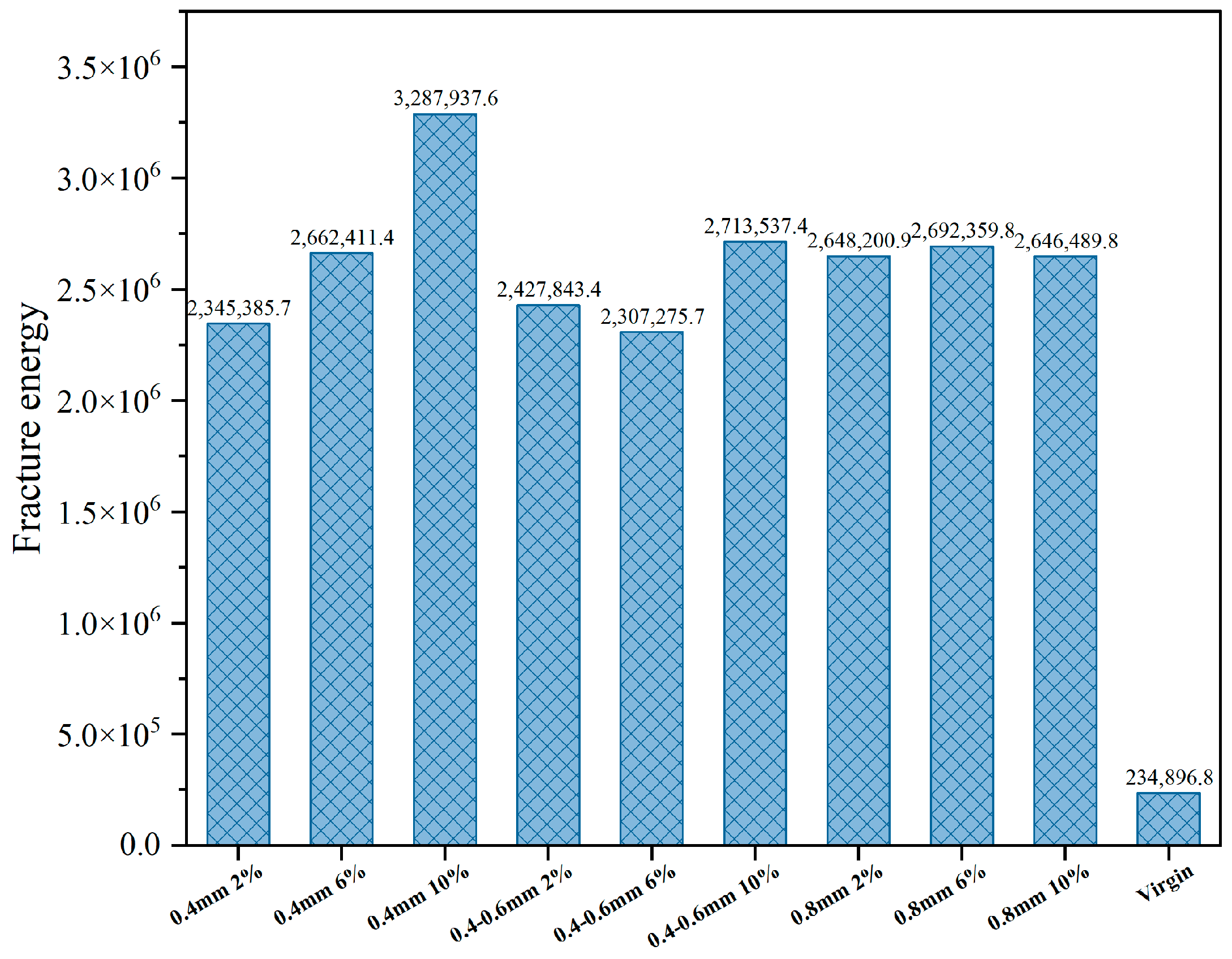
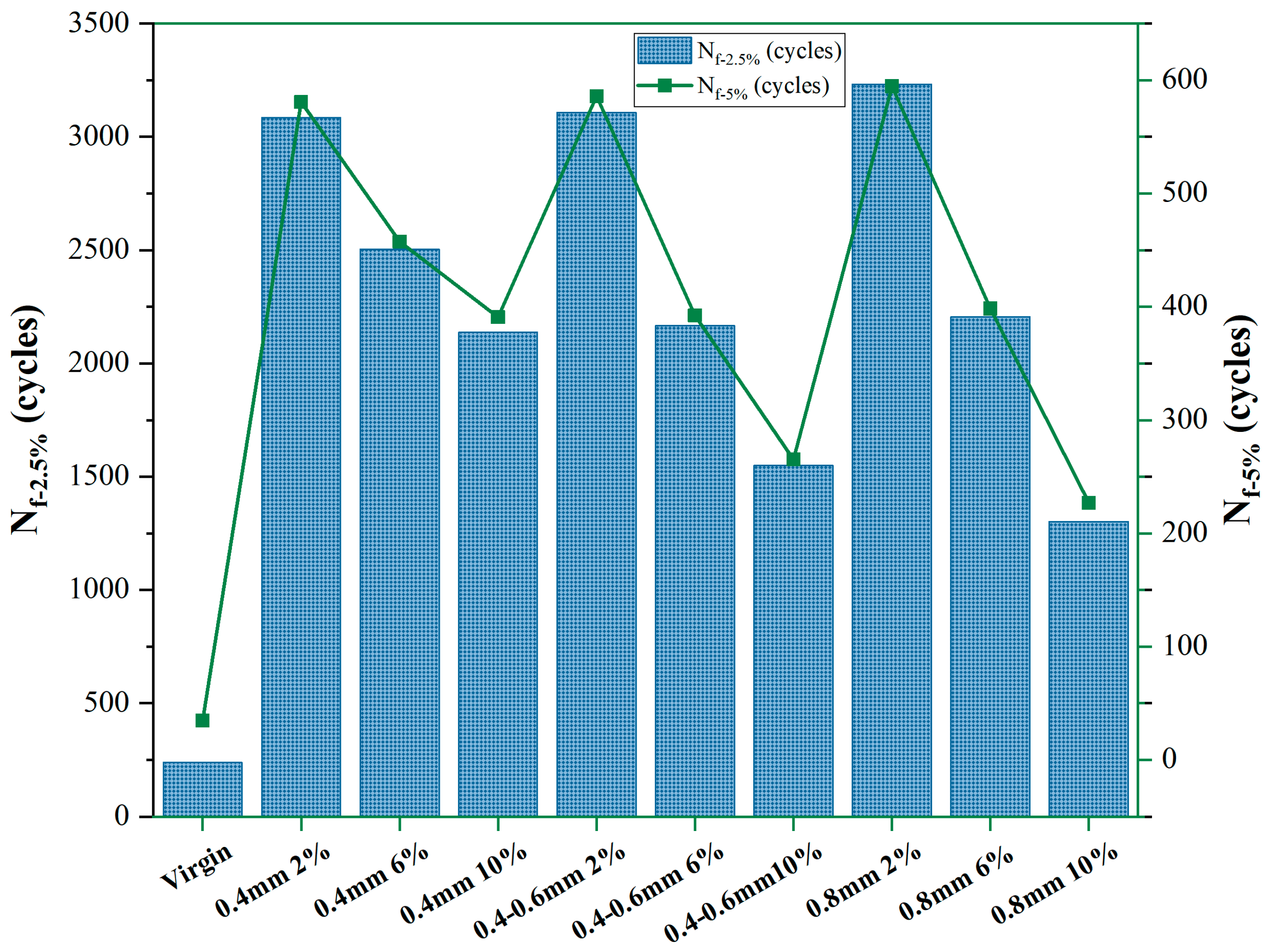




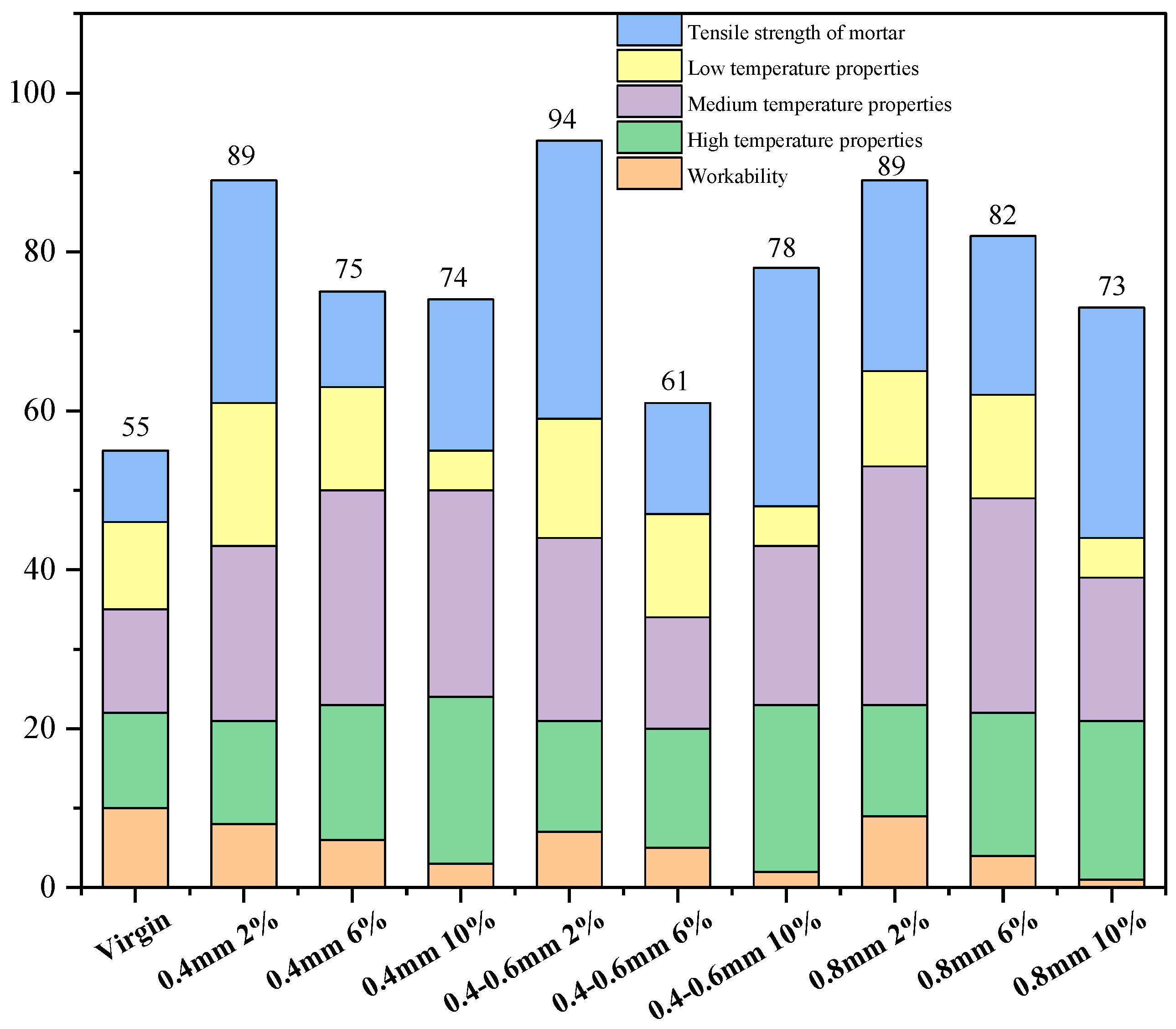
| Properties | Value | Test Standard | |
|---|---|---|---|
| 25 °C Penetration (1/10 mm) | 91 | ASTM D5 [14] | |
| Softening point (°C) | 48 | ASTM D36 [15] | |
| 135 °C Dynamic viscosity (Pa·s) | 0.8 | AASHTO T316 [16] | |
| 25 °C Density | 1.017 | EN 15326 [17] | |
| 60 °C Density | 0.996 | ||
| Chemical fractions (wt %) | Saturate, S Aromatic, A Resin, R Asphaltene, AsColloidal Index CI | 3.6 53.3 30.3 12.8 | ASTM D4124 [18] |
| Element compositions | Carbon, C Hydrogen, H Oxygen, O Sulphur, S Nitrogen, N | 84.06 10.91 0.62 3.52 0.9 | ASTM D7343 [19] |
| Complex shear modulus (kPa) | 2.4 | AASHTO M320 [20] | |
| Phase angle at 1.6 Hz (°) | 84.5 |
| Property | Density | Tensile Strength | Elastic Modulus | Lignin Content | Moisture Content |
|---|---|---|---|---|---|
| Range | 1.1~1.2 g/cm3 | 30~70 MPa | 2.5~4.5 GPa | 20~30% | 10~15% |
| Species | Sand | Bitumen | Filler | Reed Fiber | ||
|---|---|---|---|---|---|---|
| 2% | 6% | 10% | ||||
| Dosage | 100 g | 50 g | 50 g | 1 g | 3 g | 5 g |
| Property | Source | Grain Size | Specific Gravity | Bulk Density | Moisture Content | Fineness Modulus | Gradation | Silt and Clay Content |
|---|---|---|---|---|---|---|---|---|
| Values | crushed sand | 0.075 mm to 4.75 mm (ASTM C33 [33] Standard) | 2.63 g/cm3 | 1.52 g/cm3 | 0.5% | 2.6 | Conforms to ASTM C33 specifications | <5% |
| Workability Parameters | 0.4 mm 2% | 0.4 mm 6% | 0.4 mm 10% | 0.4–0.6 mm 2% | 0.4–0.6 mm 6% | 0.4–0.6 mm 10% | 0.8 mm 2% | 0.8 mm 6% | 0.8 mm 10% | Virgin |
|---|---|---|---|---|---|---|---|---|---|---|
| Viscosity | 8 | 6 | 3 | 7 | 5 | 2 | 9 | 4 | 1 | 10 |
| High-Temperature Properties | ||||||||||
| Jnr 0.1 | 2 | 5 | 8 | 3 | 6 | 10 | 4 | 7 | 9 | 1 |
| Jnr 3.2 | 2 | 5 | 8 | 3 | 6 | 10 | 4 | 7 | 9 | 1 |
| Jnr diff | 9 | 7 | 5 | 8 | 3 | 1 | 6 | 4 | 2 | 10 |
| Medium-Temperature Properties | ||||||||||
| LAS–Fracture energy | 3 | 7 | 10 | 4 | 2 | 9 | 6 | 8 | 5 | 1 |
| Fatigue life—5% strain | 8 | 7 | 4 | 9 | 5 | 3 | 10 | 6 | 2 | 1 |
| Fatigue life—2.5% strain | 8 | 7 | 4 | 9 | 5 | 3 | 10 | 6 | 2 | 1 |
| Cracking length at failure | 3 | 6 | 8 | 1 | 2 | 5 | 4 | 7 | 9 | 10 |
| Low-Temperature Properties | ||||||||||
| Maximum stress | 9 | 7 | 1 | 5 | 6 | 2 | 4 | 8 | 3 | 10 |
| Relaxation(T10) | 9 | 6 | 4 | 10 | 7 | 3 | 8 | 5 | 2 | 1 |
| Tensile strength of mortar | ||||||||||
| Tensile strength of mortar −5 °C | 6 | 4 | 9 | 7 | 5 | 10 | 3 | 1 | 8 | 2 |
| Tensile strength of mortar −20 °C | 8 | 2 | 3 | 10 | 4 | 5 | 9 | 3 | 7 | 1 |
| Fracture energy −5 °C | 6 | 4 | 1 | 8 | 2 | 10 | 3 | 9 | 7 | 5 |
| Fracture energy −20 °C | 8 | 2 | 6 | 10 | 3 | 5 | 9 | 4 | 7 | 1 |
| Total ranking value | 89 | 75 | 74 | 94 | 61 | 78 | 89 | 82 | 73 | 55 |
Disclaimer/Publisher’s Note: The statements, opinions and data contained in all publications are solely those of the individual author(s) and contributor(s) and not of MDPI and/or the editor(s). MDPI and/or the editor(s) disclaim responsibility for any injury to people or property resulting from any ideas, methods, instructions or products referred to in the content. |
© 2024 by the authors. Licensee MDPI, Basel, Switzerland. This article is an open access article distributed under the terms and conditions of the Creative Commons Attribution (CC BY) license (https://creativecommons.org/licenses/by/4.0/).
Share and Cite
Chen, H.; Zhang, J.; Niu, D.; Liu, X.; Lin, P. Influence of Reed Fiber Length and Dosage on the Properties of Reed-Fiber-Modified Bitumen and Bituminous Mortar. Buildings 2024, 14, 2749. https://doi.org/10.3390/buildings14092749
Chen H, Zhang J, Niu D, Liu X, Lin P. Influence of Reed Fiber Length and Dosage on the Properties of Reed-Fiber-Modified Bitumen and Bituminous Mortar. Buildings. 2024; 14(9):2749. https://doi.org/10.3390/buildings14092749
Chicago/Turabian StyleChen, Huikun, Junyan Zhang, Dongyu Niu, Xueyan Liu, and Peng Lin. 2024. "Influence of Reed Fiber Length and Dosage on the Properties of Reed-Fiber-Modified Bitumen and Bituminous Mortar" Buildings 14, no. 9: 2749. https://doi.org/10.3390/buildings14092749
APA StyleChen, H., Zhang, J., Niu, D., Liu, X., & Lin, P. (2024). Influence of Reed Fiber Length and Dosage on the Properties of Reed-Fiber-Modified Bitumen and Bituminous Mortar. Buildings, 14(9), 2749. https://doi.org/10.3390/buildings14092749








